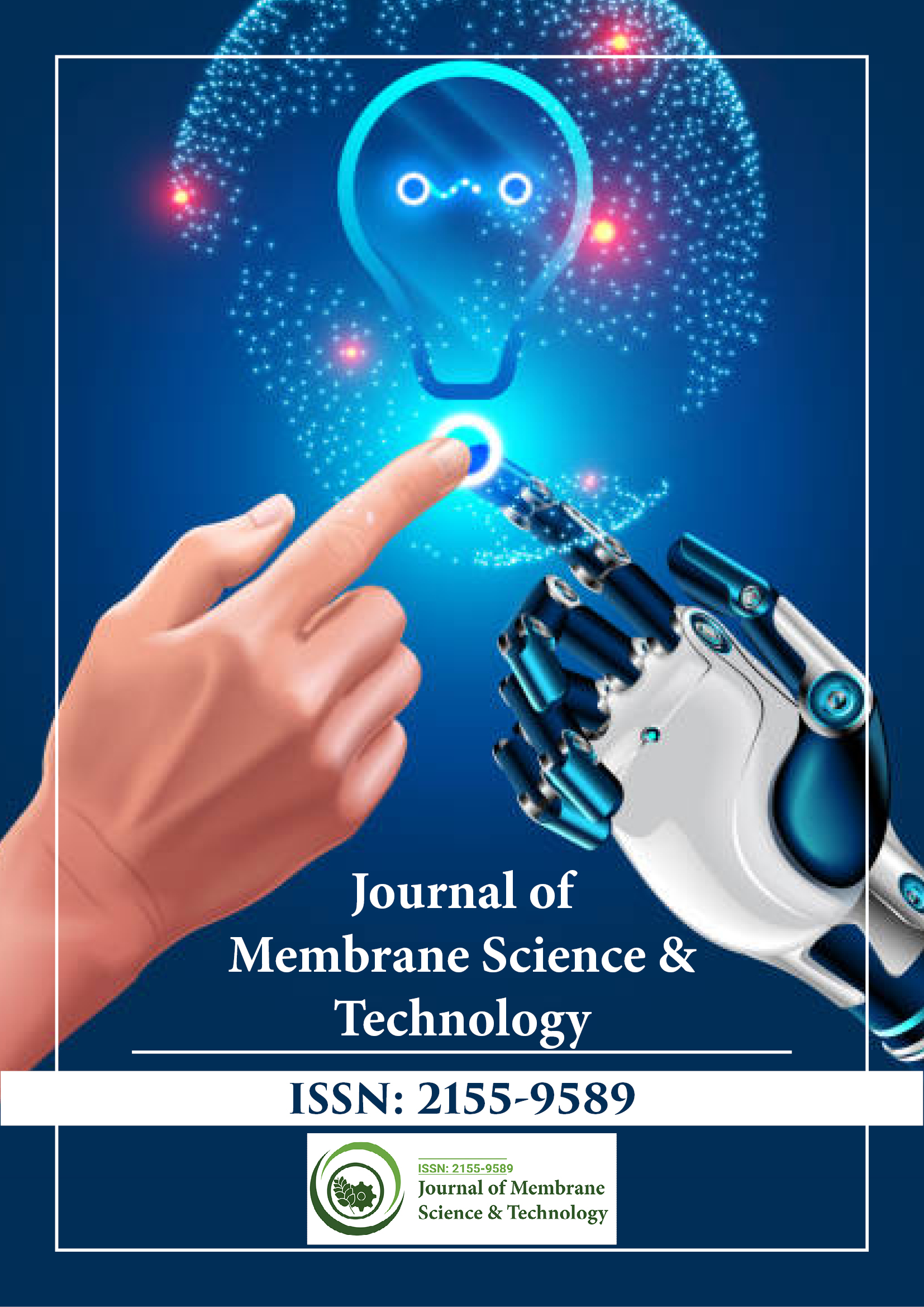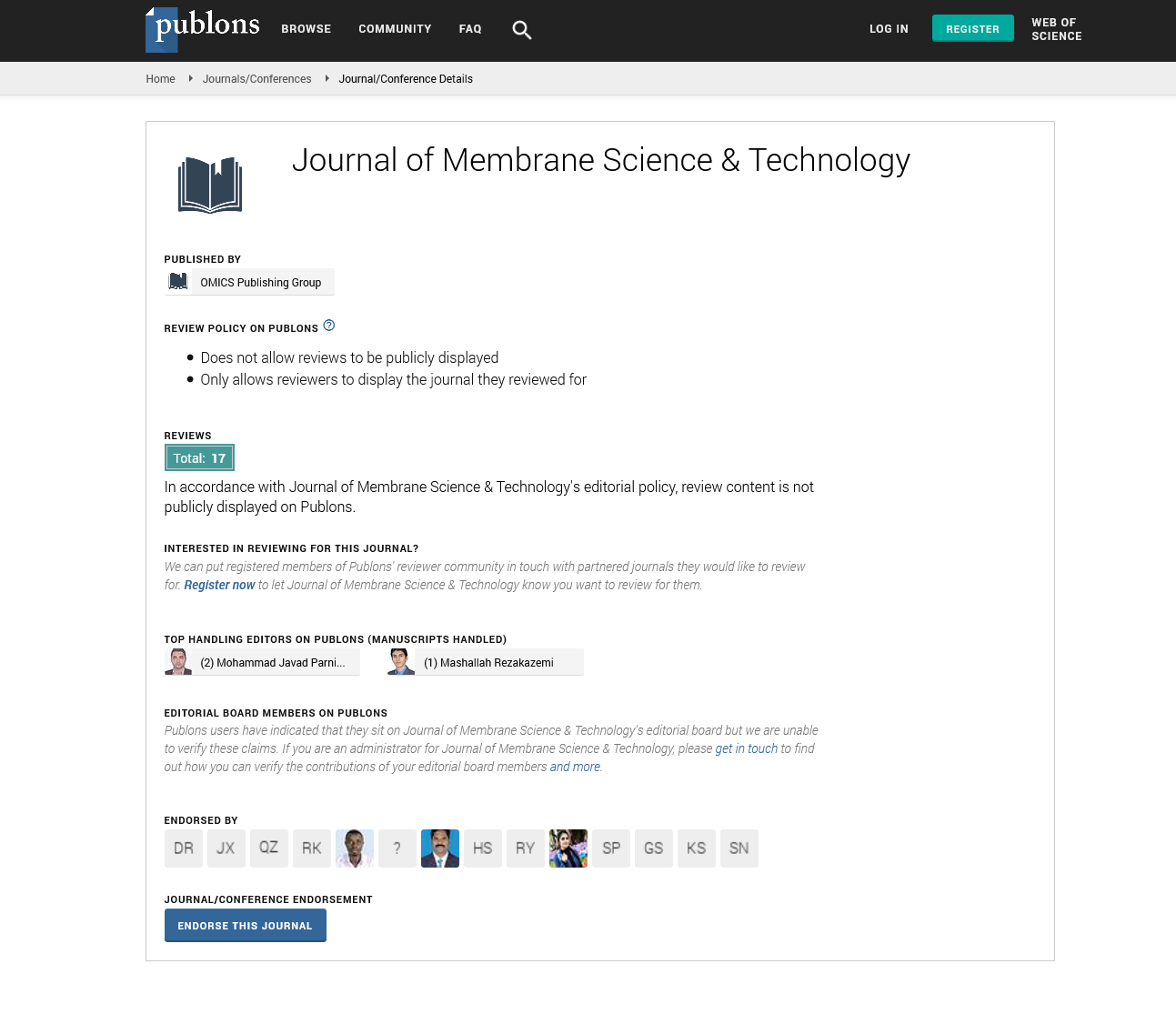Indexed In
- Open J Gate
- Genamics JournalSeek
- Ulrich's Periodicals Directory
- RefSeek
- Directory of Research Journal Indexing (DRJI)
- Hamdard University
- EBSCO A-Z
- OCLC- WorldCat
- Proquest Summons
- Scholarsteer
- Publons
- Geneva Foundation for Medical Education and Research
- Euro Pub
- Google Scholar
Useful Links
Share This Page
Journal Flyer

Open Access Journals
- Agri and Aquaculture
- Biochemistry
- Bioinformatics & Systems Biology
- Business & Management
- Chemistry
- Clinical Sciences
- Engineering
- Food & Nutrition
- General Science
- Genetics & Molecular Biology
- Immunology & Microbiology
- Medical Sciences
- Neuroscience & Psychology
- Nursing & Health Care
- Pharmaceutical Sciences
Short Communication - (2025) Volume 15, Issue 1
Semipermeable Layer: Understanding Its Role and Applications in Science and Technology
Sakurai Roy*Received: 31-Jan-2025, Manuscript No. JMST-25-29282; Editor assigned: 03-Feb-2025, Pre QC No. JMST-25-29282 (PQ); Reviewed: 17-Feb-2025, QC No. JMST-25-29282; Revised: 24-Feb-2025, Manuscript No. JMST-25-29282 (R); Published: 03-Mar-2025, DOI: 10.35248/2155-9589.25.15.418
Description
A semipermeable layer, commonly known as a semipermeable membrane, functions as a selective barrier that permits the passage of certain molecules or ions while blocking others. This unique characteristic of selective permeability plays a crucial role in numerous biological, chemical and industrial processes. By understanding how semipermeable layers work, scientists and engineers have been able to develop applications that significantly impact fields such as medicine, environmental engineering and water treatment.
At its core, a semipermeable layer is a thin membrane that allows specific substances typically solvents like water to pass through while restricting solutes, such as salts, large molecules, or particles. This selective movement is essential for processes like osmosis, dialysis and filtration, where the controlled transfer of substances is necessary to achieve separation or purification. The structure of these membranes is designed to be selectively permeable, meaning that only molecules meeting certain criteria related to size, charge, or chemical properties can traverse them. To be effective, semipermeable membranes are usually very thin, facilitating efficient transport, yet they must possess adequate mechanical strength to withstand pressures or tensions encountered during use. Additionally, these membranes require chemical stability to resist degradation under operating conditions, ensuring durability over time [1].
Semipermeable layers exist in both natural and synthetic forms, each suited to different environments and applications. Biological semipermeable membranes are intrinsic to living organisms; for example, cell membranes act as natural barriers regulating the flow of nutrients and waste products in and out of cells. Similarly, capillary walls within the circulatory system selectively permit exchange between blood and tissues, playing an essential role in maintaining homeostasis. On the synthetic side, polymeric membranes made from materials such as cellulose acetate or polyamide have become widely used, particularly in water purification technologies. Ceramic membranes offer greater chemical and thermal resistance, making them suitable for harsh industrial environments. Composite membranes combine different materials to enhance overall performance, balancing durability and selectivity [2].
The transport mechanisms through semipermeable membranes vary depending on the system and application. Osmosis, a fundamental process, involves the movement of solvent molecules from an area of lower solute concentration to one of higher concentration through the membrane. This natural phenomenon is harnessed in various technologies, including water purification. Diffusion allows molecules to passively move down their concentration gradient, while in biological systems, active transport can move substances against gradients, often requiring energy input. In industrial applications, pressure-driven flow is common; reverse osmosis is a prime example, where applied pressure forces water through a membrane, separating it from dissolved salts and impurities [3].
Semipermeable membranes have found widespread use across numerous industries, with water treatment and desalination being among the most prominent. They enable the conversion of seawater and wastewater into potable water by efficiently removing salts and contaminants. In medicine, semipermeable membranes are central to dialysis, where they filter waste products from the blood of patients with kidney failure. Additionally, membranes control the release of drugs in targeted delivery systems, improving treatment efficacy and patient outcomes. The food and beverage industry benefits from membranes by concentrating and purifying liquids such as juices and milk without the need for heat, which can degrade quality. Environmental protection efforts also rely heavily on membrane technology, using filtration to treat industrial effluents, thereby reducing pollution and recovering valuable resources [4,5].
The advantages of semipermeable membranes include their high selectivity, which enables targeted separation and purification of substances. Many processes using these membranes are energy-efficient, leveraging natural gradients like osmotic pressure to reduce power consumption. Their scalability allows applications ranging from small medical devices to large industrial plants, making them versatile tools in various settings. Furthermore, they contribute to improved product quality by producing pure and consistent outputs, critical for both consumer products and industrial feedstocks [6].
Despite their benefits, semipermeable membranes face several challenges. One significant issue is membrane fouling, where particles accumulate on the surface or within the pores, reducing permeability and efficiency. High-quality membranes often come with substantial production and maintenance costs, which can limit accessibility, especially in developing regions. Durability is another concern, as some membranes degrade under harsh chemical or thermal conditions, necessitating frequent replacement. The limited lifespan of membranes adds to operational expenses and resource use, highlighting the need for ongoing improvements [7].
Recent innovations aim to overcome these limitations. Advances in materials science have introduced nanomaterials and graphene-based membranes, offering superior selectivity, strength and chemical resistance. Self-cleaning membranes are being developed to reduce fouling and maintenance requirements, extending membrane life and performance. Smart membranes equipped with embedded sensors provide real-time monitoring and control, enhancing operational efficiency and safety. Additionally, efforts to promote sustainable production include eco-friendly manufacturing processes and biodegradable membranes, addressing environmental concerns associated with membrane disposal [8-10].
Conclusion
In summary, semipermeable layers are vital components across many scientific and technological domains. Their ability to selectively allow substances to pass while blocking others underpins critical processes that improve human health, provide clean water and protect natural ecosystems. Continuous research and development are expanding their capabilities, making semipermeable membranes more efficient, durable and versatile. As global challenges related to water scarcity, environmental protection, and medical needs grow, these membranes will remain indispensable tools in creating innovative and sustainable solutions.
References
- Ma X, Ma Y, Zhou J, Xiong S. The recycling of spent power battery: Economic benefits and policy suggestions. IOP Conference Series Earth Environ Sci. 2018;159(1):012017.
- Shannon MA, Bohn PW, Elimelech M, Georgiadis JG, Mariñas BJ, Mayes AM. Science and technology for water purification in the coming decades. Nature. 2008;452(7185):301-310.
- Mulder M. Basic principles of membrane technology. Springer Science & Business Media; 2012.
- Werber JR, Osuji CO, Elimelech M. Materials for next-generation desalination and water purification membranes. Nat Rev Mater. 2016;1(5):16018.
- Kaminski M, Zydney AL. Membrane filtration: A user’s guide and reference manual. CRC Press; 2019.
- Van der Bruggen B, Vandecasteele C. Removal of pollutants from surface water and groundwater by nanofiltration: Overview of possible applications in the drinking water industry. Environ Pollut. 2003;122(3):435-445. cc
- Lin S, Freeman BD. Gas permeation and separation properties of poly(ethylene oxide) containing polymer membranes. Macromolecules. 2006;39(7):2388-2397.
- Mulder M, Bouwman M, Wessling M. Water and solute transport in reverse osmosis membranes. J Membr Sci. 2013;444:37-44.
- Nwachi AC, Nwakaeze EA, Romanus II. Development of membrane bioreactors (MBR) for sustainable urban wastewater treatment. Path Sci. 2025;11(5):2009-16.
- Rahman TU, Roy H, Islam MR, Tahmid M, Fariha A. The advancement in membrane bioreactor (MBR) technology toward sustainable industrial wastewater management. Membranes. 2023;13(2):181.
Citation: Roy S (2025) Innovative Membrane Bioreactor Systems: Transforming Wastewater Treatment with Advanced Filtration and Biological Processes. J Membr Sci Technol. 15:418.
Copyright: © 2025 Roy S. This is an open-access article distributed under the terms of the Creative Commons Attribution License, which permits unrestricted use, distribution, and reproduction in any medium, provided the original author and source are credited.

